Kilimanjaro Part I:
The Ascent
And at that particular moment he saw it for the first time since they’d been on the mountain; the peak of Kilimanjaro stood before him in the distance, illuminated by the glowing moon
Arrival & Intro
We had just got on a plane from Nairobi, Kenya and were finally en-route to Kilimanjaro International airport in Tanzania. We’d spent a week in Kenya, having experienced a proper Safari (unlike back in the UK or the rest of the world outside Africa where they keep predators separate from other animals) and had spent much of the day waiting for a delayed plane which had crashed in Nairobi and thus had to be replaced. But that is all a story for another blog – for now let’s focus on getting to Kilimanjaro!
As we approached the airport, the pilot took a slight detour and allowed us to get right up along the side of the mountain. As we peered through the windows (literally everyone on the plane moved over to the left side – we were thankful it didn’t tilt over) we got our very first glimpse of the largest freestanding mountain in the world: Kilimanjaro (which from now on will just be referred to as ‘Kili’ for the remainder of the blog). There was something inspiring about looking out (we say ‘out’ and not looking ‘down’ as we were level with the peak) at the great mountain and knowing that in a week’s time we would be at the summit! At the same time, one could argue now that we’d seen the peak close up – was 8 days of trekking really worthwhile? The answer to that is a resounding ‘yes’ but with its challenges for sure!
We eventually moved past the mountain and got ready to land. All the people with seats on the right side of the plane migrated back to their places (little tip: if you get a plane with no assigned seats like we did then maybe ask the cabin crew when you get on which side you’ll be able to see Kili from) and we landed in one piece.

We had chosen a climbing company recommended through a friend to get us up the mountain called Top Climbers. One of their staff picked us up at the airport to drive us to Moshi, the town where we would be staying that night. He also picked up one of our guides (called Chunga) halfway to the hotel (we assume this pickup had been planned and we didn’t coincidentally pick up a hitch-hiker that turned out to be a Top Climbers guide), who briefed us on what we were about to do over the next week. We had an early night and braced ourselves for an early pickup the next morning.
As usual with our blogs, we will be recounting the story in as vivid detail as we can (but not too vivid as this blog comes complete with diarrhea episodes, nausea, toilet training sessions and many hours of continuous walking) as well as providing useful insight and tips for any readers interested in climbing Kili themselves. We had opted to take the Lemosho route, which would take us 8 days total (up and down), which also included some days for acclimatization (meaning we would go up and come down slightly in elevation during the climb en-route to the summit). There are various routes which can be taken but we would advise you to do your research to see which one you feel best suits you if you ever want to do the climb.
Let the climb begin!

Day 1: Big Tree/Mti Mkubwa Camp (2650 metres)
Meet the Team
We were picked up early from the hotel and stopped off at the Top Climbers office to pickup our rented gear (we will cover all the gear you need later in the blog) and pay the final balance (please do reach out to us if you want an idea of prices we paid). We then set off for the western side of Kili and got an opportunity to meet the other 5 hikers on the tour (but more on them later).
When we got to the gate (Londorosi Gate), which is about 2 hours outside of Moshi by car, we had lunch while the guides and porters organized the weighing of the bags. This process seemed to take ages, but we later learnt that there are strict rules for the porters with regards to how much additional weight they are allowed to carry up the mountain (the maximum limit being 20kg). This rule was apparently put in place due to porters dying on the mountain from trying to carry too much. But we will cover the porters in greater detail a bit later on.
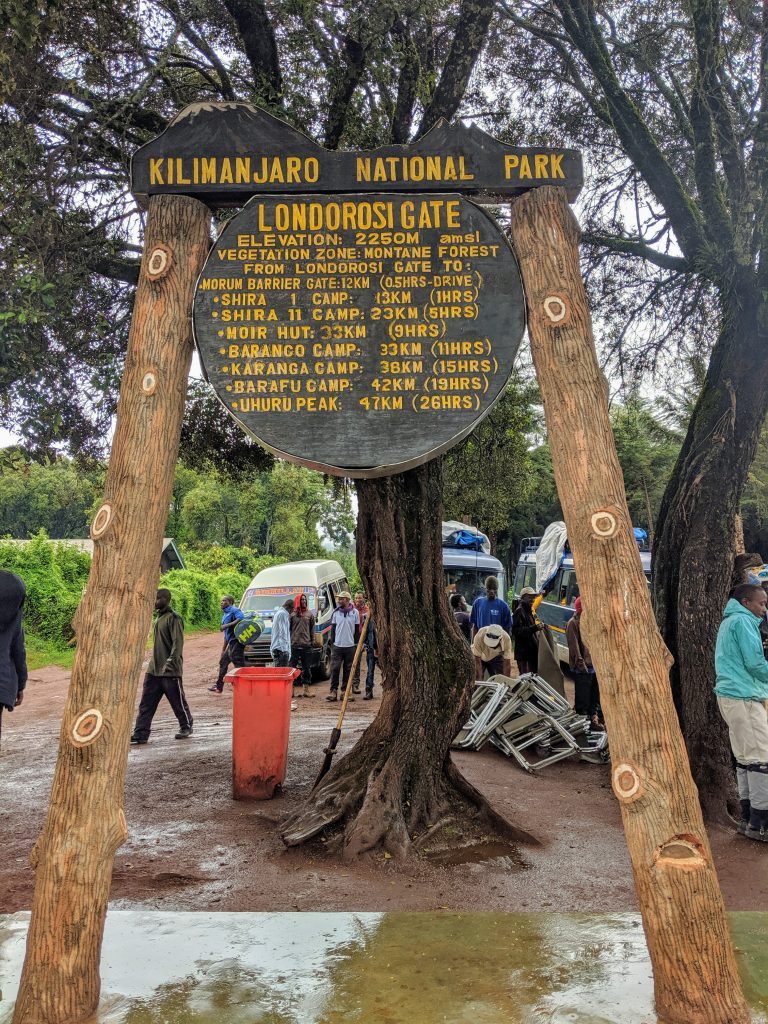
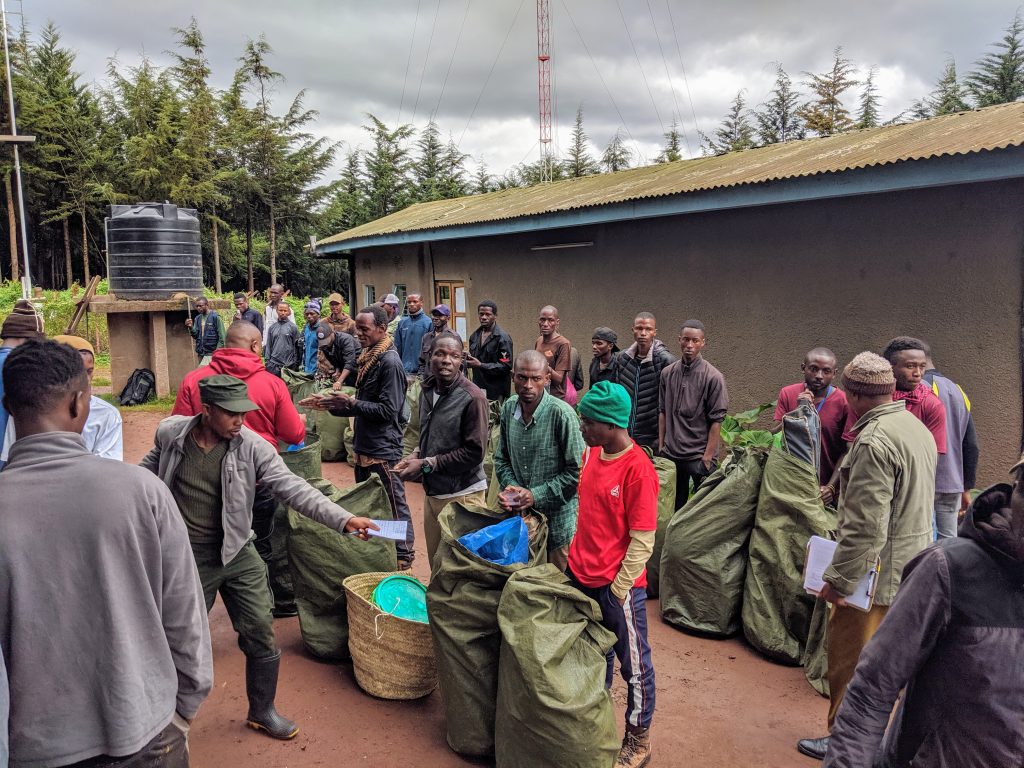
We eventually set off from the gate after registering with the National Park (this is where the statistics come from in case you wonder why your age and occupation are required fields to fill in when registering) and at this point there was only a little bit of rain. It took us just under 4 hours to reach Big Tree Camp (aka Mti Mkubwa) and gave us some opportunity to engage with the other hikers. Within the next day or so we’d all have nicknames assigned to help us remember who was who:
Casper (because she had a white poncho that made her look like a friendly ghost)
Papa bear (because he had his son with him – I guess)
Townie (because she came from a town I guess…)
‘No one’ (because we couldn’t think of anything else – he was the last to be named)
The porter (because he was always ahead and kept pace with the porters)
Djokovic (this was Shri based on his doppelganger)
Queen (this is Firuza – most likely due to her obsession with tea and the ‘correct’ way to make it)
For ease of writing, these will be the names used for the remainder of this blog – it may also help with data protection too if that is ever needed……..
It goes without saying that when undertaking a challenge like this it’s best to get on with the other climbers as you will be spending a ton of time together and will at some point need the support of each other. As you can imagine, having this type of experience can be ten times better when you get on with everyone and manage to bond together which we think we all did pretty well!
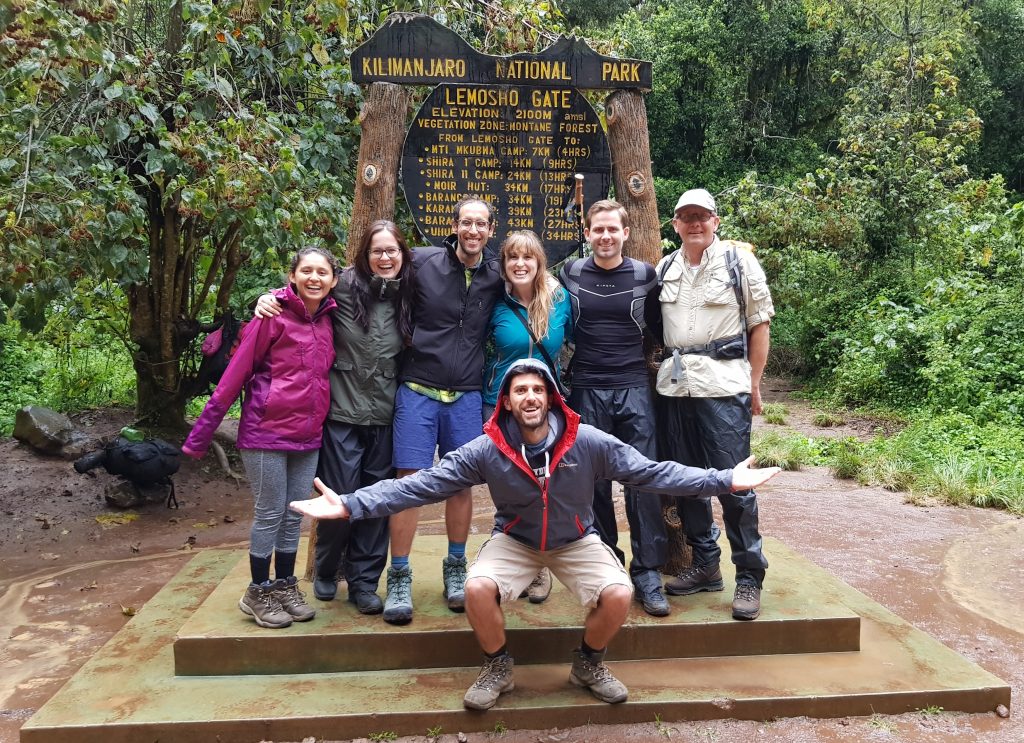

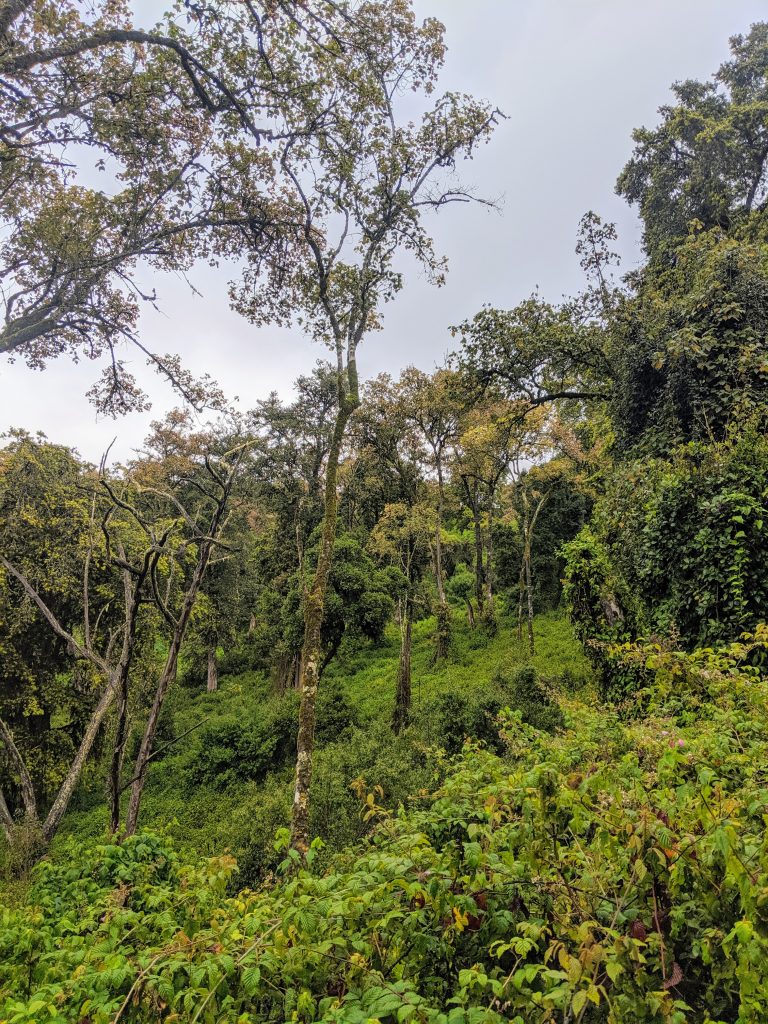
The Toilet Master
When we arrived at the first camp, the tents were all already setup for us, another tent with a dining table had been erected for us to eat and washbowls had been placed outside of each of our tents for us to clean our faces and get ready for dinner.
We couldn’t help notice a buzz of energy in the air – the camp was alive! There were guides and porters talking busily amongst themselves, new climbers arriving and discussing their new tents, birds and wildlife chirping in the tress, the sound of monkeys in the distance and the clatter of pots and pans as the chefs prepared food. All in all it was an amazing atmosphere for the first night and gave us excitement and energy as we looked forward to the coming days.
efore dinner though, we were told to gather around the smallest tent in our section of the camp. This tent was black and shaped slightly oddly compared to the rest – we wouldn’t have been surprised to find death hiding under there. Masu – another one of our guides signaled to one of the porters to come over.
“This is Emmanuel” he said, “he is the toilet master, the toilet expert”.
Emmanuel then proceeded to unzip the tent and a small portable toilet was revealed. We were given an in-depth demonstration of how to use the toilet, how to flush and what to avoid doing.
With regards to the toilet, we as a group had to pay a little extra to take this toilet up the mountain with us (essentially we paid for an extra porter who would bring this up the mountain for us). Some may say that this is a waste of money, but when the alternative is holes in the ground in designated out-houses when at camp (while trekking you can go in the bush but while at camp you will be fined for going in non-designated areas) which at some camps are very far from your tent in freezing conditions – the toilet becomes money well spent!
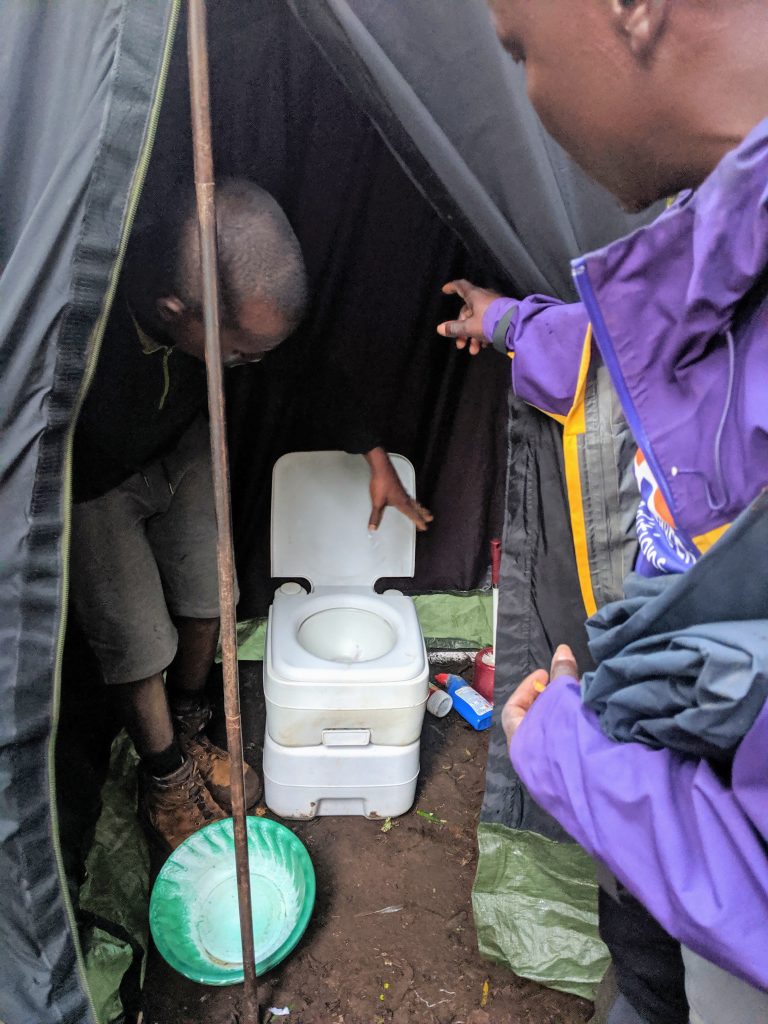
Shri decided to use a hole in one of the out-houses that night because it seemed easier to just stand rather than get all finicky in that small little tent – plus he had only briefly listened to the toilet instructions as he’d been distracted by monkeys during the demonstration. Dinner was great (courtesy of our chef) and the evening passed with out event.
We nodded off to sleep on day 1 with a general buzz of the camp still inside us, optimistic for the journey ahead. But things change quickly on the mountain…
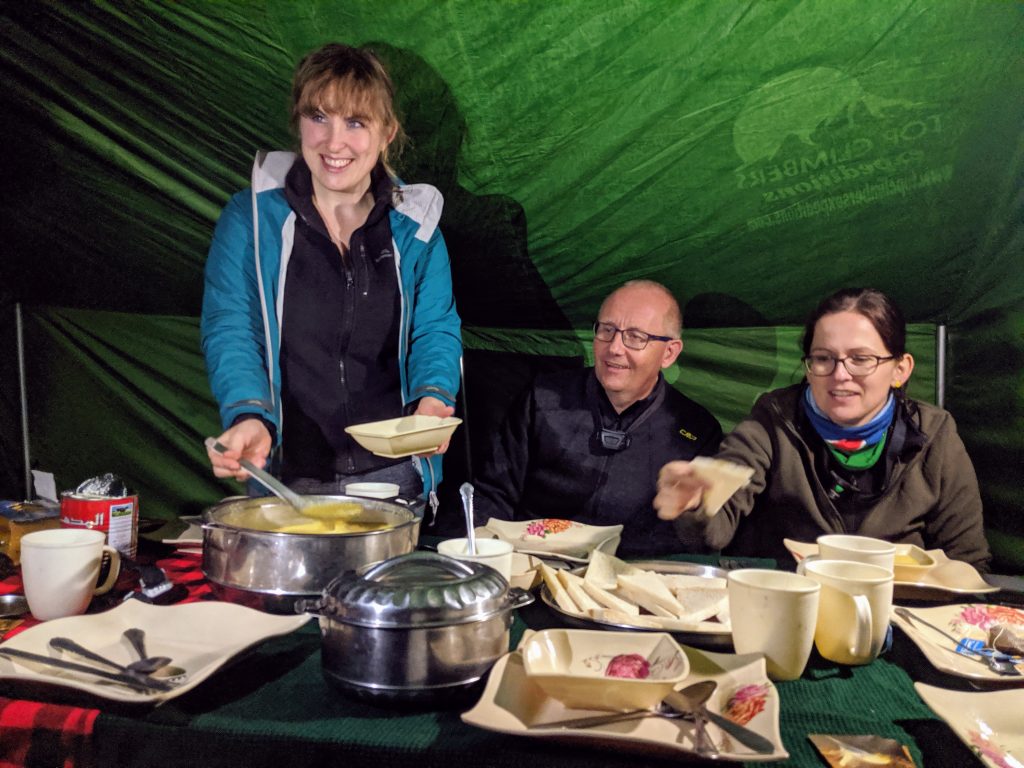
Day 2: Shira Camp I (3500 metres)
Here comes the rain
The entire group was still in good spirits the next morning. We were awoken early by one of the porters who brought us tea in our tent (we think this is the tactic to make sure we don’t just go back to sleep) before being brought some warm water to wash our faces with. Breakfast was just as great as dinner (and still gluten free options were provided for Firuza).
We set off as one group and began making our way to the next camp: Shira Camp I. The atmosphere was good and we were all talking amongst the guides, and ourselves with no negative thought in mind at all! You’d occasionally hear one of the guides call out “Pole Pole” which essentially means ‘slowly, slowly’. This way nobody runs up too quickly and gets altitude sickness.

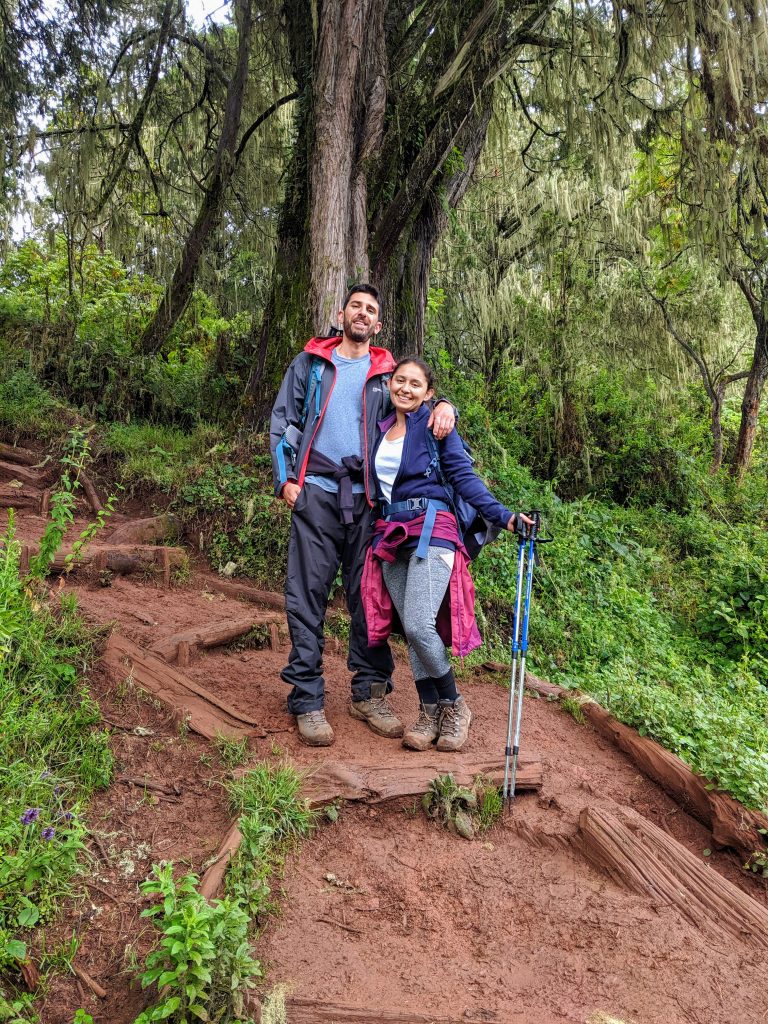
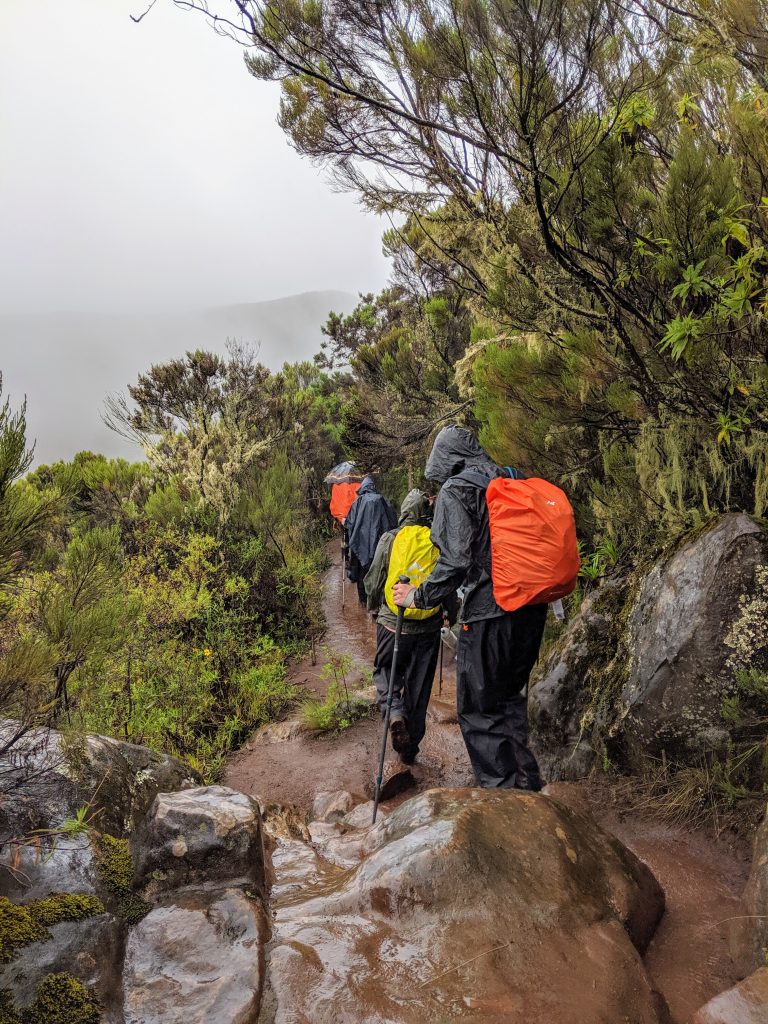
Just under an hour after we set off the rain began in the forest. We all put our waterproof gear on and continued unperturbed as this was a just a little rain – we’ve been in it plenty of times and our waterproof gear had always held up before. Remember that phrase!
We made our way through dense luscious rainforest surroundings. It was so green! But within about three hours of the rain starting we were all drenched. Waterproof clothing may be waterproof after walking in the rain for a few hours in the UK, but they most definitely aren’t if you’re walking up Kili for a few hours. All the big brands got completely wet through and even our waterproof shoes and socks ended up getting water inside them. We’d often think it’s just in our imagination, there can’t really be water pooling around our feet – but actually there could and there was!
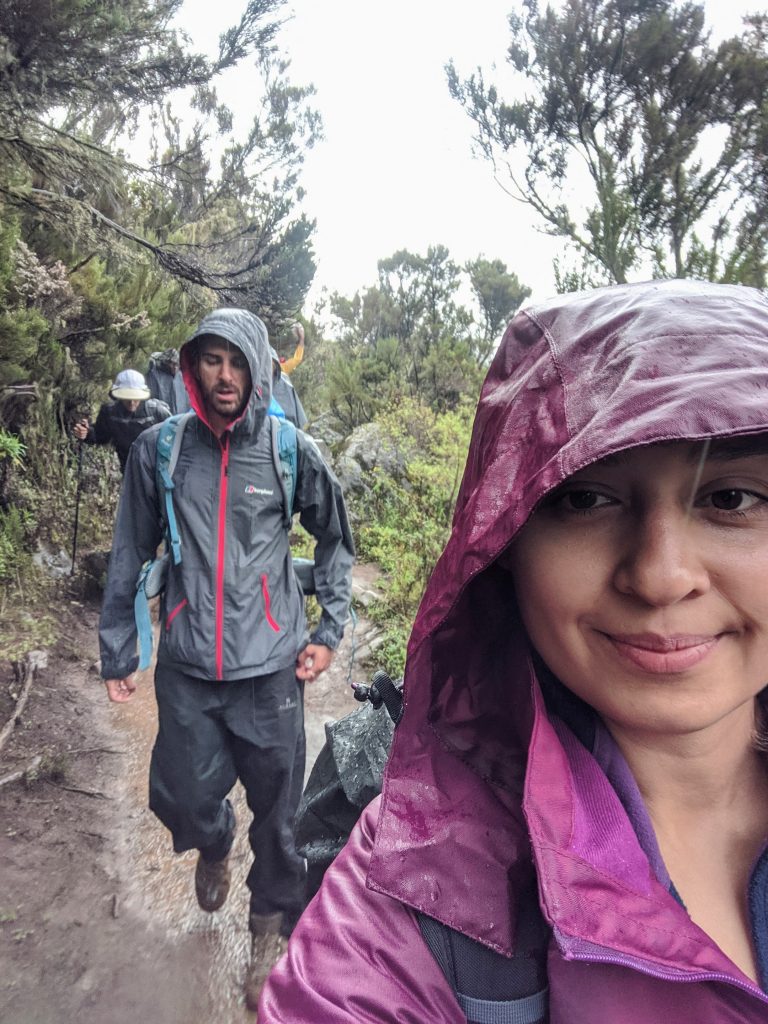
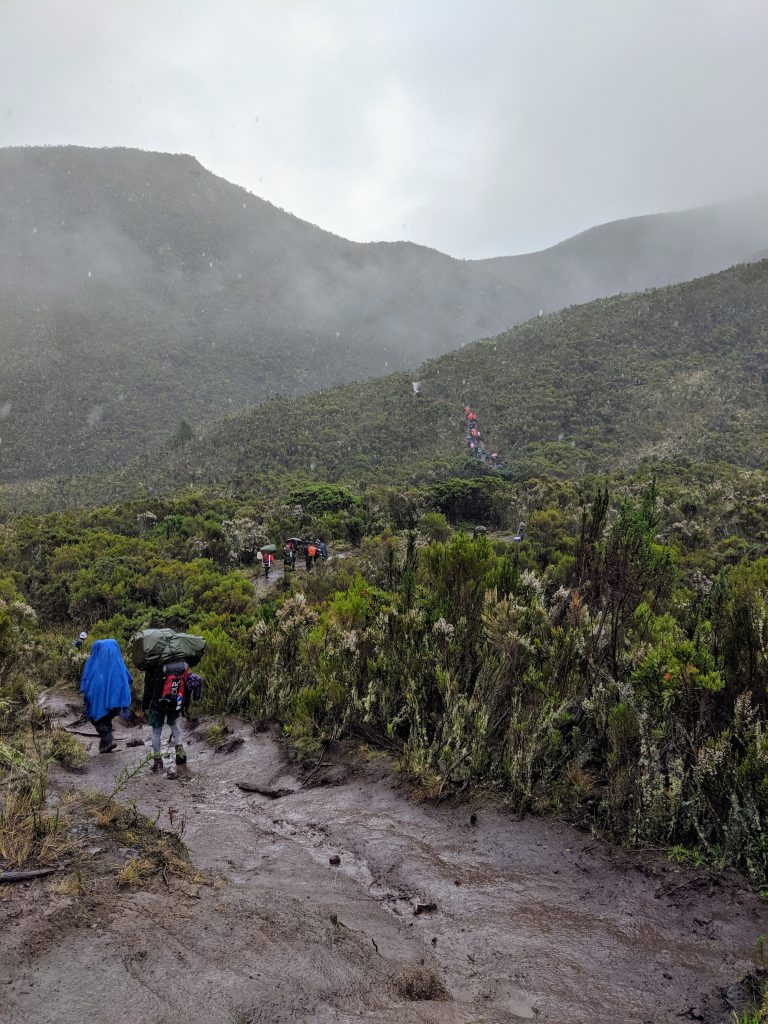
The Magic of Cards
We arrived at Shira Camp cold, wet and several minutes later even colder than we had been due to the drop in movement. Only one tent was setup when we arrived (the main one where had breakfast in that morning at the previous camp) and we all ended up huddled in there until the porters had come and setup our sleeping tents where we could change out of our wet clothes. Spare a thought here for the porters who had climbed to this camp with three times as much on their backs as us, gotten here quicker to setup the main tent and were then still out in the cold with lesser waterproof gear than us setting up our sleeping tents (and the toilet tent don’t forget).
When we eventually got into our tent we found that one of the sleeping bags was wet (the other was a little damp too) and our clothes in our big backpacks had also been drenched while being carried up the mountain. This included clothes for the next day, warm clothes for the summit, gloves, scarves etc. At this point we just sat in our tent with wet clothes, listening to the continued force of the rain outside and wondering how we would get through the next 6 days with no dry clothes, no end in sight for the rain and wet sleeping bags for the night.
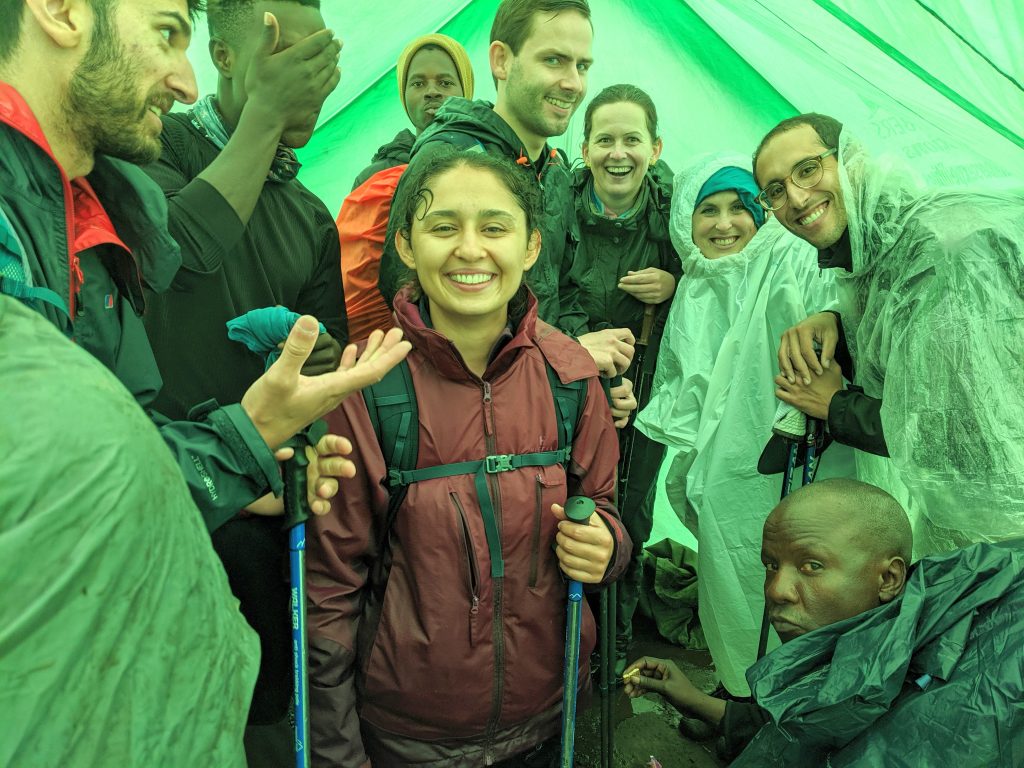
After several more minutes of feeling like a victim, having a feeling of hopelessness etched inside our stomachs and wondering if we would make it up to the summit Firuza had an idea. “Let’s hang our most important clothes up in the tent, I think I can make a makeshift washing line inside”. And so we did. The temporary line made little impact on actually drying the clothes but at least having an idea and successfully executing it gave us back a feeling of hope and control! If we could do this, we could climb to the top!
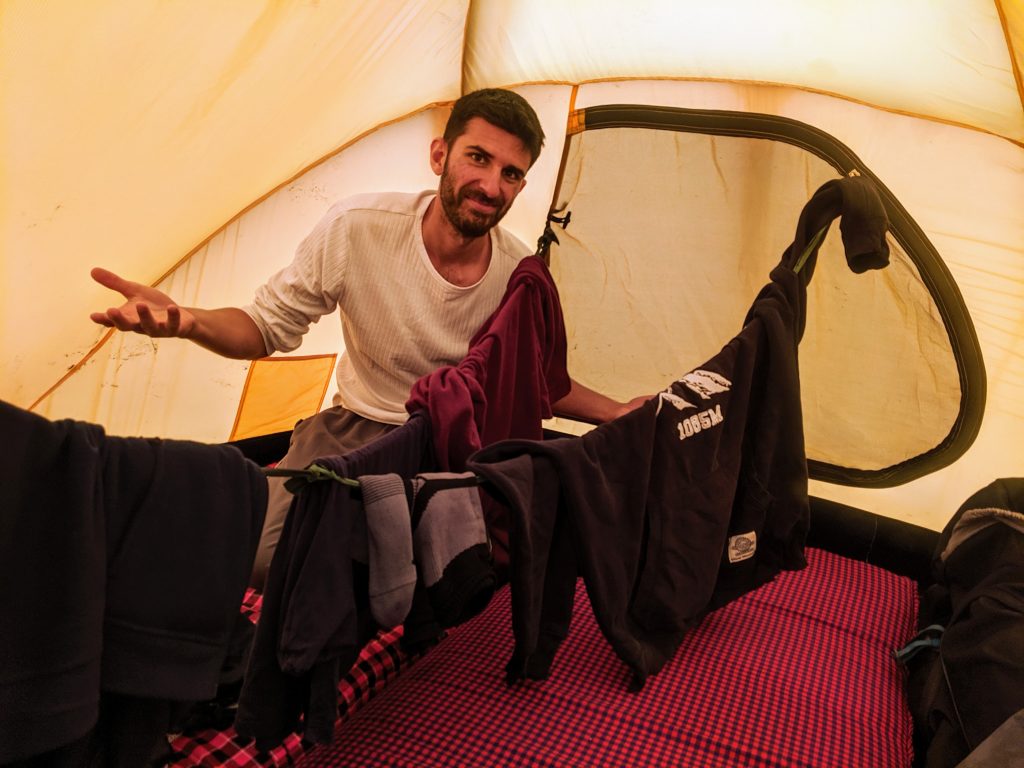
Later that night, we sat in the main tent with the others, some of us still in wet gear and most of us with wet shoes. It turned out we weren’t the only ones whose bags had also been soaked and now had no dry clothes. But, we managed to forget our collective troubles by playing cards for the rest of the night. We had bought a pack of cards for Firuza’s brother as a gift in Kenya where we had been previously. Sorry bro – but we were in our time of need and had to break the pack open!
The cards had native East African birds on the back of them and we played many games through the night (black jack, rummy, bullshit, mixed pickles) until by the time we finally went to bed we were in good spirits again.
That night we shared Firuza’s only partly damp sleeping bag while putting the wet one aside. Despite the challenges of the day, we’d ended it positively and were prepared to continue the next day. Onwards and upwards!
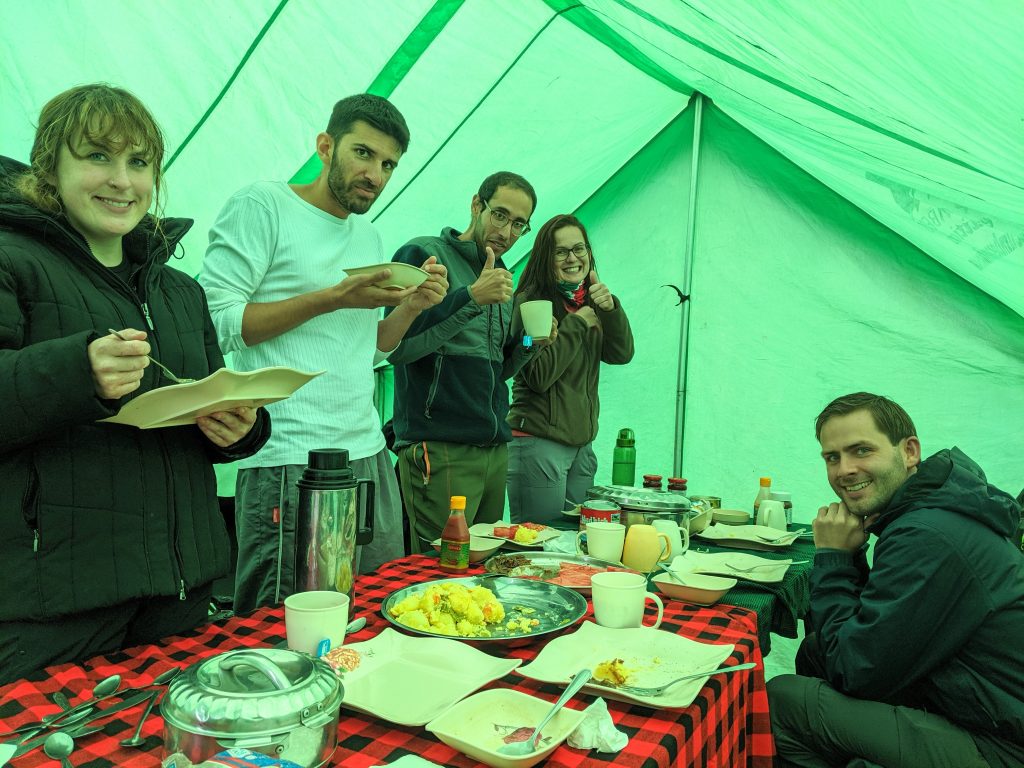
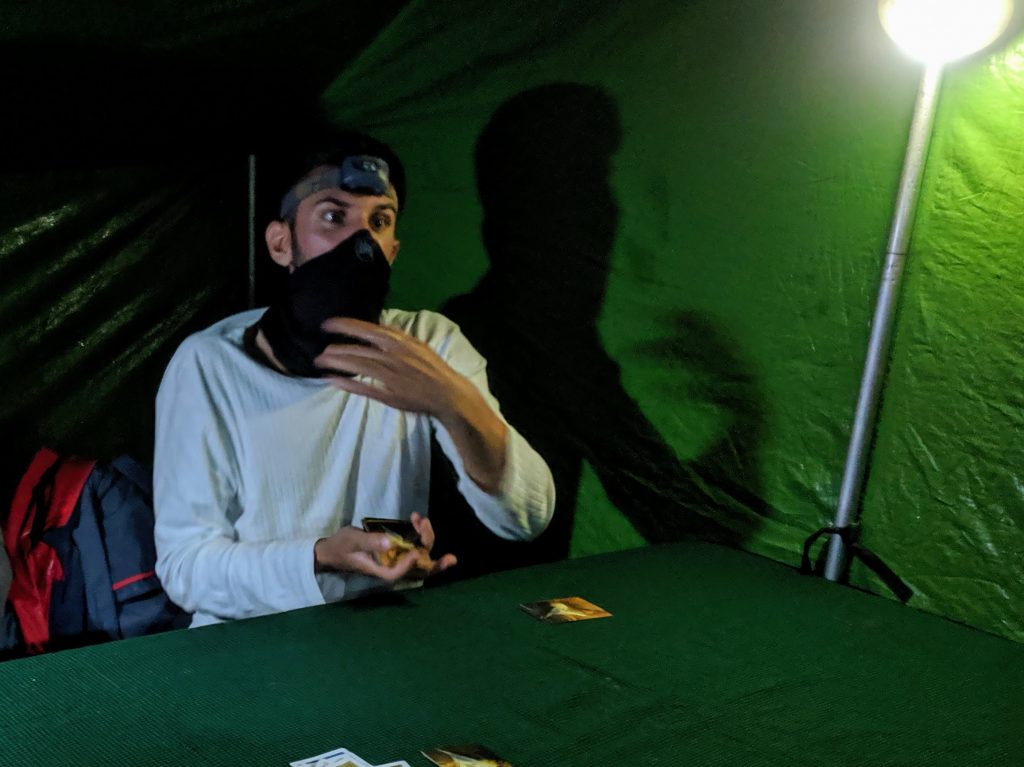
Day 3: Shira Camp II (3850 metres)
The First Glimpse
Before going to bed, Shri had told himself (and everyone else for some reason) that he wasn’t getting up to piss even if he had to in the night – he’d rather use a bottle. Well that didn’t happen, and at about 4am he decided it was best to go out and spare Firuza the experience of peeing in her water bottle which was less full than his.
As he got out though, he was greeted by a very welcome sight. The rain had stopped and the clouds had gone. While it was chilly, the moon was out in full along with a sea of stars above. And at that particular moment he saw it for the first time since they’d been on the mountain; the peak of Kilimanjaro stood before him in the distance, illuminated by the glowing moon. He took a quick picture before going to the toilet and then back to bed. But this sight had given him energy again and would help push him to reach the summit. Sometimes, a view is enough to inspire…
Once we awoke that morning, the sun was starting to rise and was warming the camp up. As you can see from some of the pictures below, everyone including the porters decided to take full advantage of this opportunity to start drying the entire contents of their wet bags on the bushes. Our clothes were spread over a wide section and we even dried out the sleeping bag on top of the tent.

It was a ‘feel good’ morning, as we happily discussed where we had hung our clothes with one another and fantasized about a dry climb for the day ahead. Somehow with the sun out breakfast tasted better than dinner the previous evening and the atmosphere was good again with excitement in the air. The crew ended up taking the tent down while we were still eating which actually meant that we were able to have breakfast in the sun with a view of Kili’s peak! Although they probably did do this so that they could pack it away early and get going.
We took a few more shots of the peak, few selfies, few more normal snaps and returned to selfies before setting off for Shira Camp II. The mantra for most of this day was: we must go before the rain comes in.
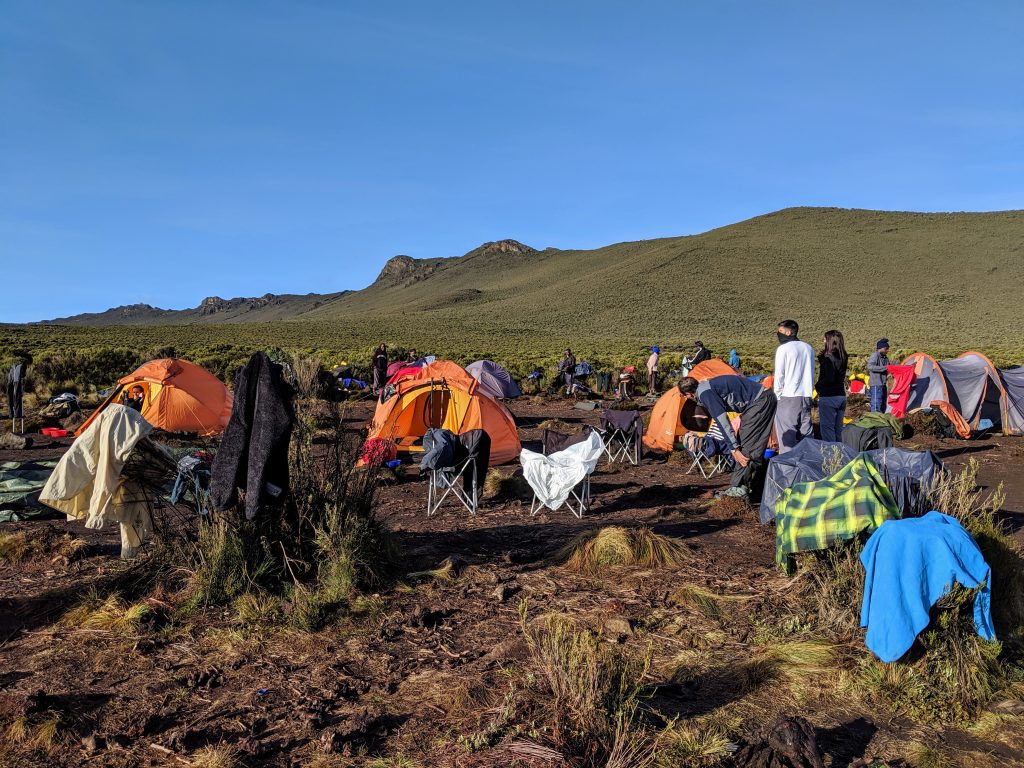
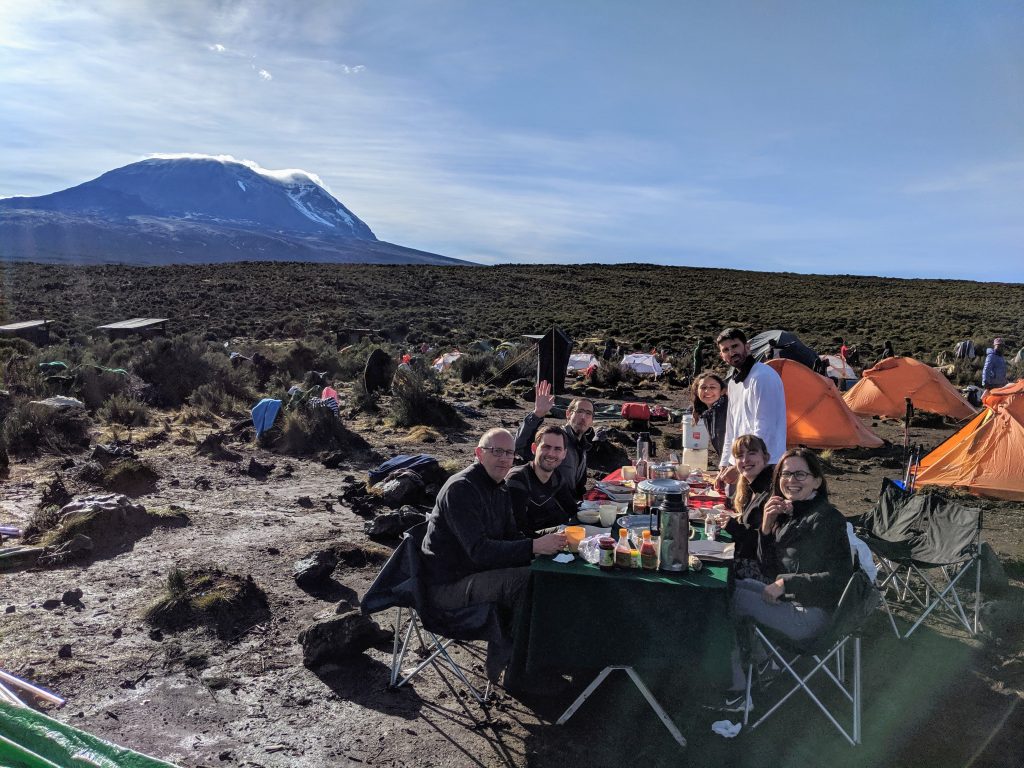
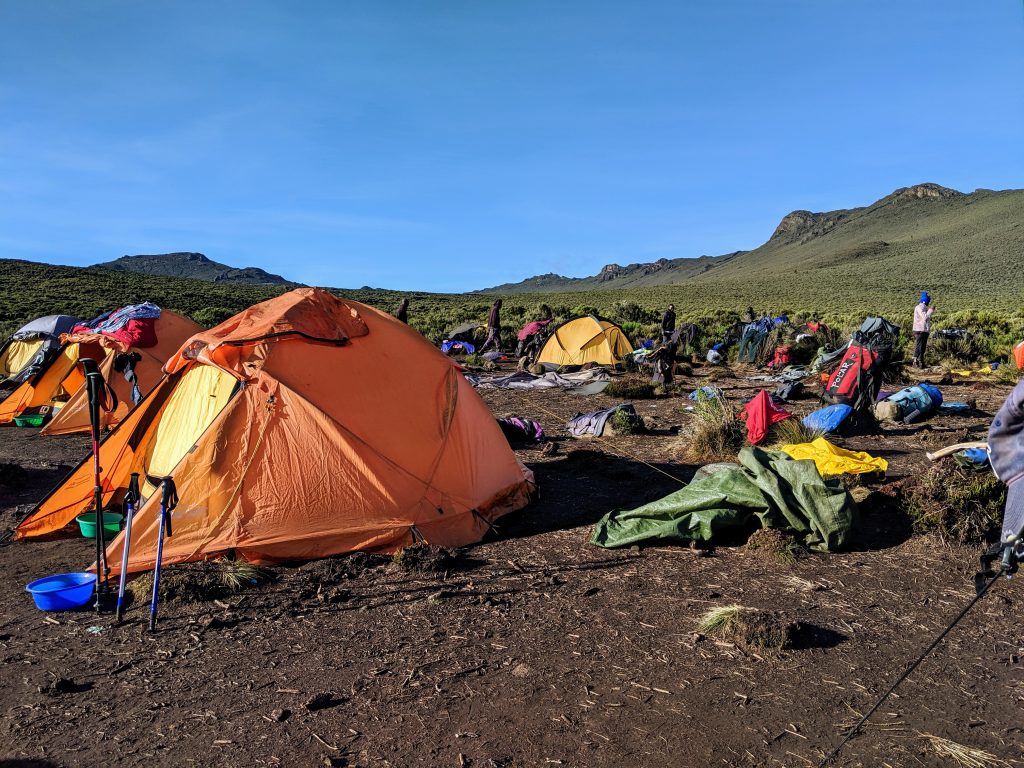
In case you didn’t notice, Firuza was so happy about seeing the sun that she forgot what day it was (Day 3, not Day 2).
The Porters
We think this is an appropriate time to have a little insight into the role of the porters on getting to the summit. We can safely say that we’d have had no chance of making it without these guys who did a tremendous job despite very harsh conditions.
On our previous trip to Peru, there had been two guides and only a handful of porters. The reason being, because we had donkeys doing the majority of the load carrying and the porters were mainly there to guide them and help prep meals. However, in Tanzania this practice is not in place as it is feared it would cause a spike in unemployment; hence the need for more porters. A lot more.
Our group of 7 hikers had 3 guides and 19 porters! Yes 19! Between them, these guys had to carry not only their own days packs every day, but also all of the food, water, our large backpacks, tents, cooking equipment, oh and don’t forget the toilet and the tent for the toilet. These guys practically ran up the mountain, always leaving after we did from each camp to pack up, and often overtaking us in order to get to the next camp and setup before we arrived.
Despite the cold, despite the rain and the slippery and frankly dangerous hikes in some places, they consistently marched on and made things easy for us. While we do this type of climb for fun, for adventure and for the challenge, they are doing this to support their families and would not be up at these altitudes in the cold if they didn’t feel they had to. For those readers who would like one day to climb Kili, please bare this in mind when you tip at the end (we will cover tips later in the blog) as a modest tip often equates to more than their wages.

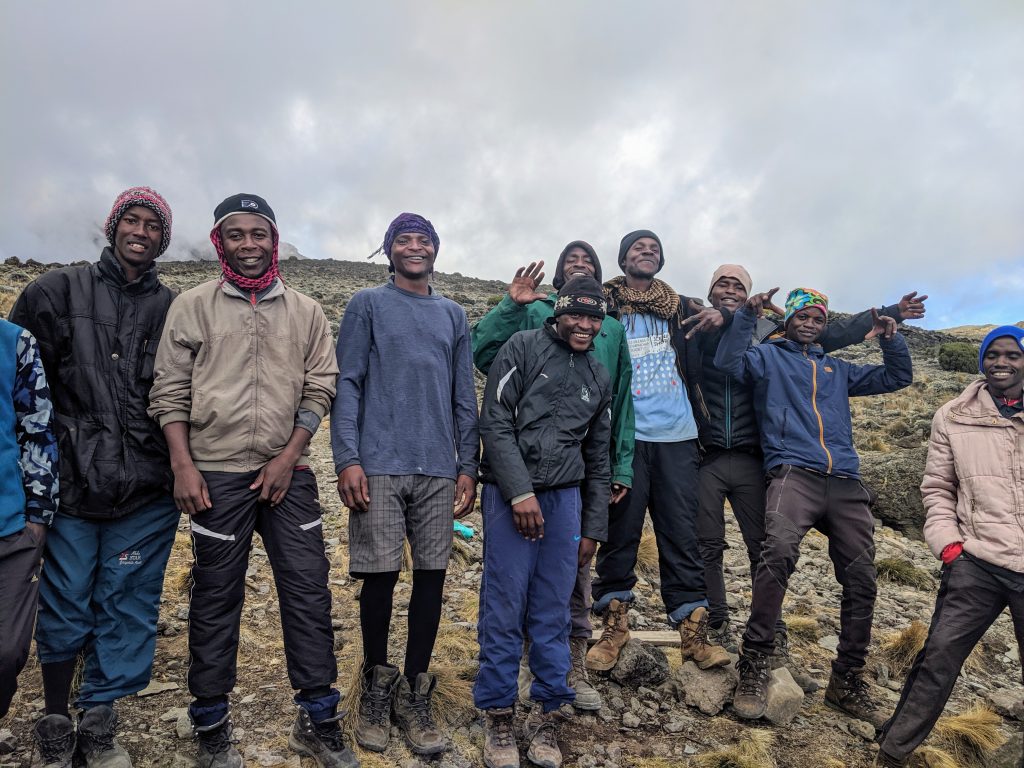
Shira Camp II (gets it’s own mini subsection)
As we continued on to the next camp, we left behind the forest and the tall tress along with the clouds, which were still hanging over the trees. We passed a lot of shorter vegetation on our way up now, and you could really feel the terrain was changing. We had stunning views of the summit throughout this hike and took advantage with lots of pictures on the way. The rain finally did catch up with us shortly before we got to the next camp, but it wasn’t as damaging as the previous day.
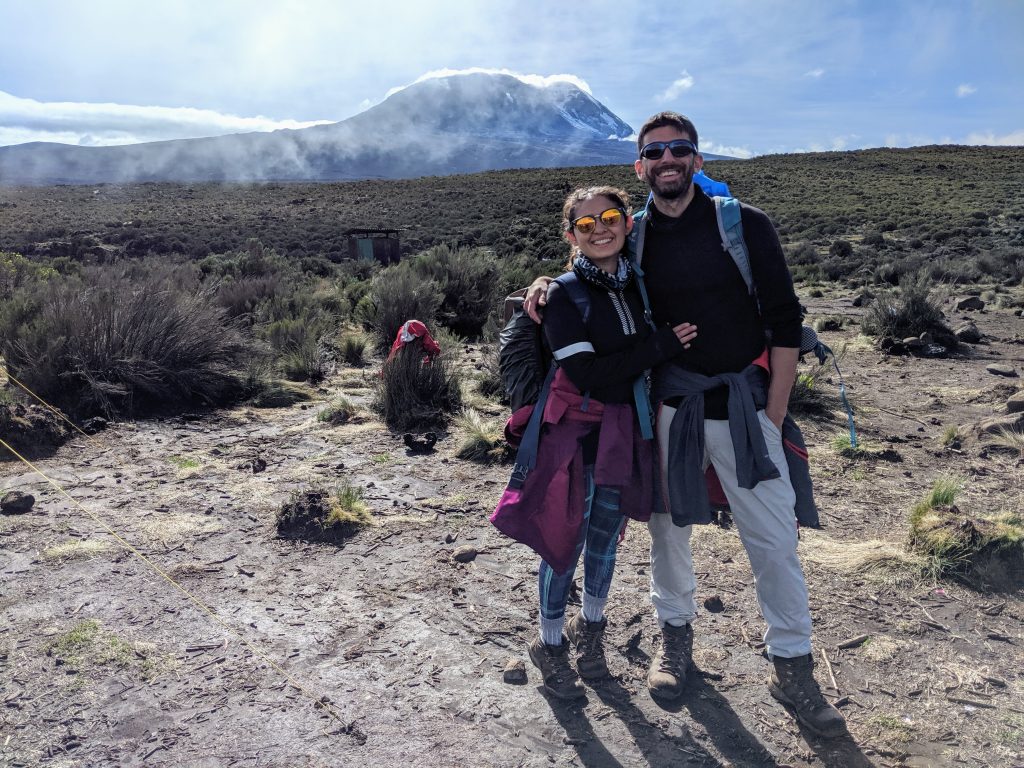
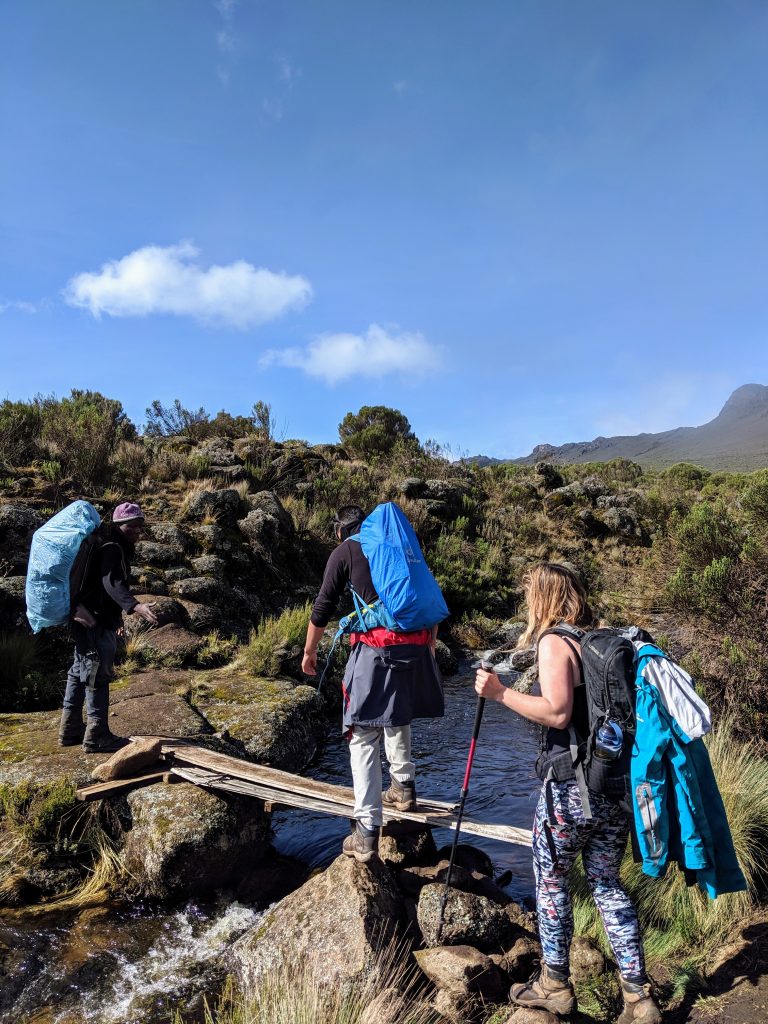

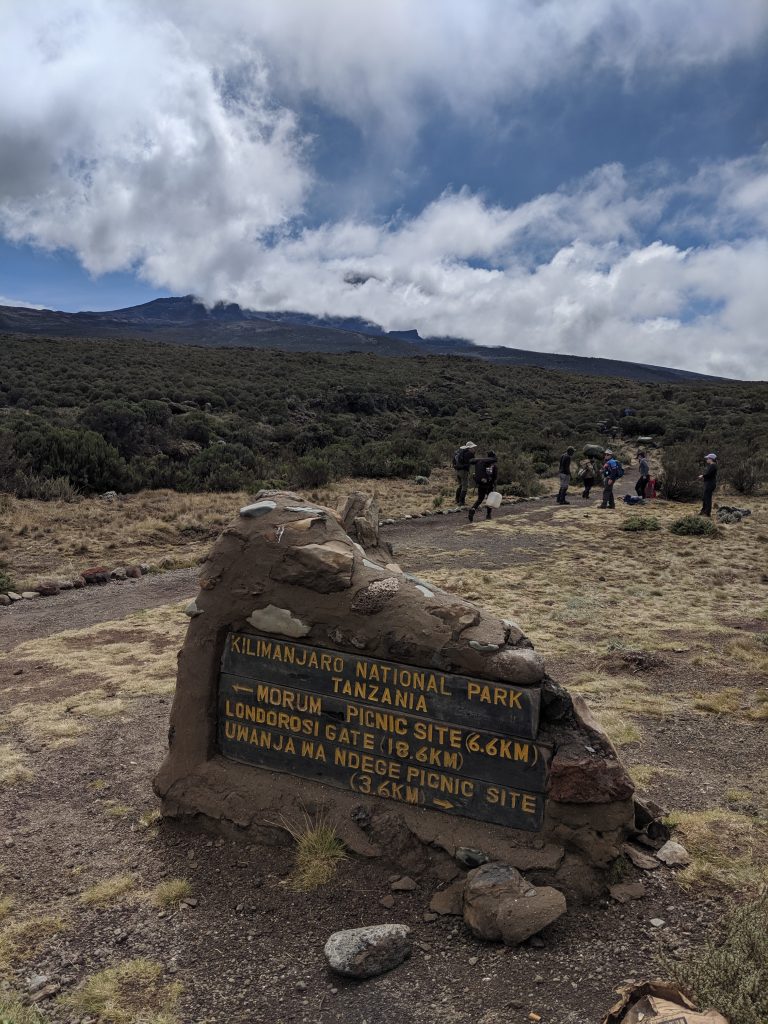
We eventually got to camp and had a more enjoyable evening than the previous night. We played cards long into the evening with some of the guides also joining us (one who tried to cheat several times as he was struggling to win). We decided to fill up our hot water bottles this evening as the temperature was getting colder as we reached higher elevation. Masu at this camp, began giving his famous phrase which we would hear up until the summit: “The cold, it comes slowly you know”. While this line could rival the Game of Throne’s ‘Winter is coming’ catch-phrase, Masu was dead serious and dead right about the way the cold slowly made it’s way in the night.
Shri went with ‘No one’ (remember our nicknames for the group) and took a little excursion that night to the actual toilets (not our little black tent), which ended up taking about 10 minutes to walk downhill to. Imagine you are bursting to go or you have bad stomach issues on the mountain and your nearest toilet is 10 mins away! If you’re planning on doing the hike, as you can now see, it’s highly advisable to get your little private portable toilet. If we haven’t already convinced you, you definitely will be by the next chapter!
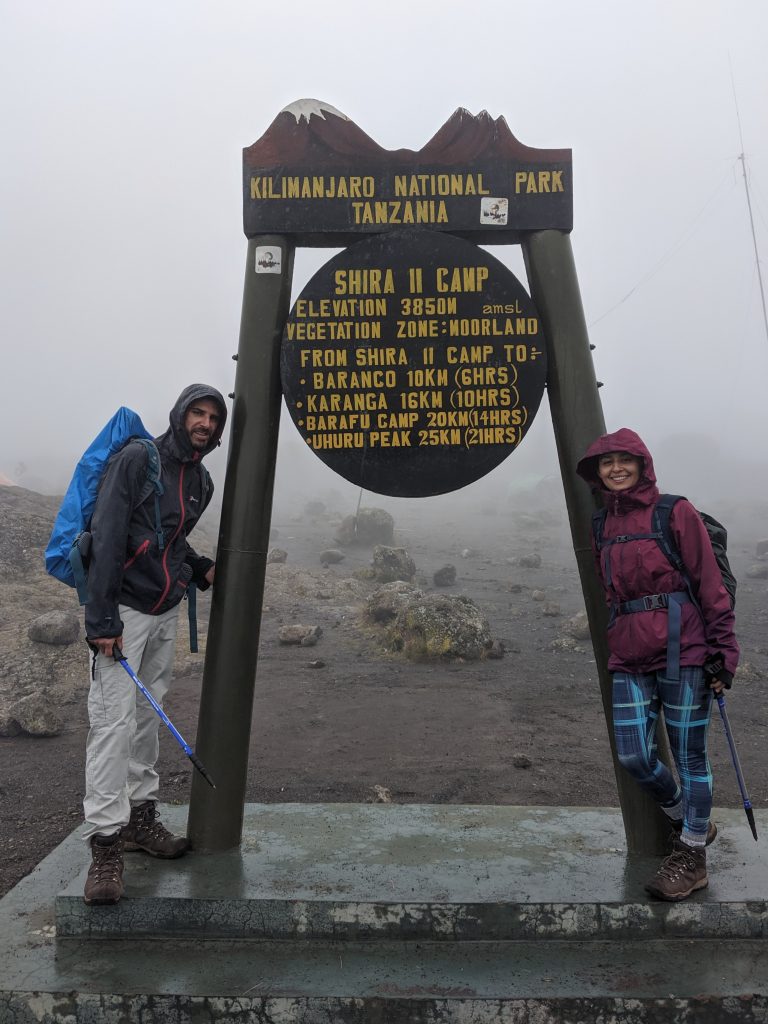
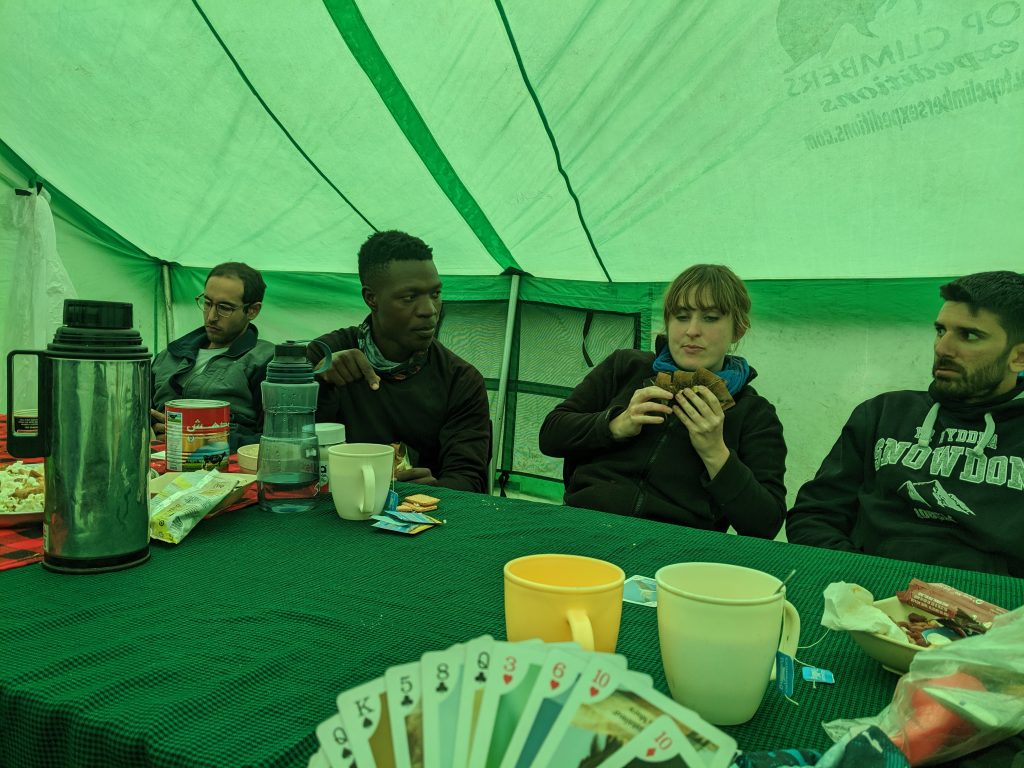
Day 4: Lava Tower (4600 metres) & Barranco Camp (3960 metres)
Shit Gets Real
The nights were getting much colder and as with last night Shri vowed not to go to the toilet until sunrise. Again this wasn’t to be but for different reasons. He awoke with a bad stomach and decided this could not wait. He unzipped the tent with difficulty as it had frosted over on the outside. He made his way quickly to the toilet tent where he had serious diarrhoea. You may wonder why we go into this level of detail, but this was a big part of the experience and is quite possible to happen to anyone climbing the mountain. Also, this is an explicit blog; we leave no detail uncovered so as a reader you know you won’t miss out!
As he made his way back to the tent, he noticed the clouds had subsided and the peak was again in clear view. Somehow, it seemed very far away despite being closer than the previous night. But at this moment, with his stomach still not feeling great, he realized just how big a challenge it was going to be to reach the summit. He went to the toilet 4 times that night between midnight and 5am. Luckily nobody else had been queuing for it at the same time otherwise things might have gotten messy.
Firuza hadn’t taken much notice in the night, and when she had, she’d been relatively annoyed at why he was constantly leaving the tent and making her cold. It was only the next morning that he managed to explain to her (now that her ear buds were out) that she took sympathy. She also had a good idea:
Imodium – the 8th Wonder of the World
She gave him Imodium and that seemed to work for the time being. At breakfast he asked Casper (who happened to be a doctor) if it was advisable to continue to take it for the rest of the trip (after your first dose, you’re only supposed to take it after loose bowel movement). She agreed that it would not be too bad if he essentially made himself constipated for a few days on the mountain. And so he did, and he never needed that toilet again for diarrhoea for the remainder of the climb.

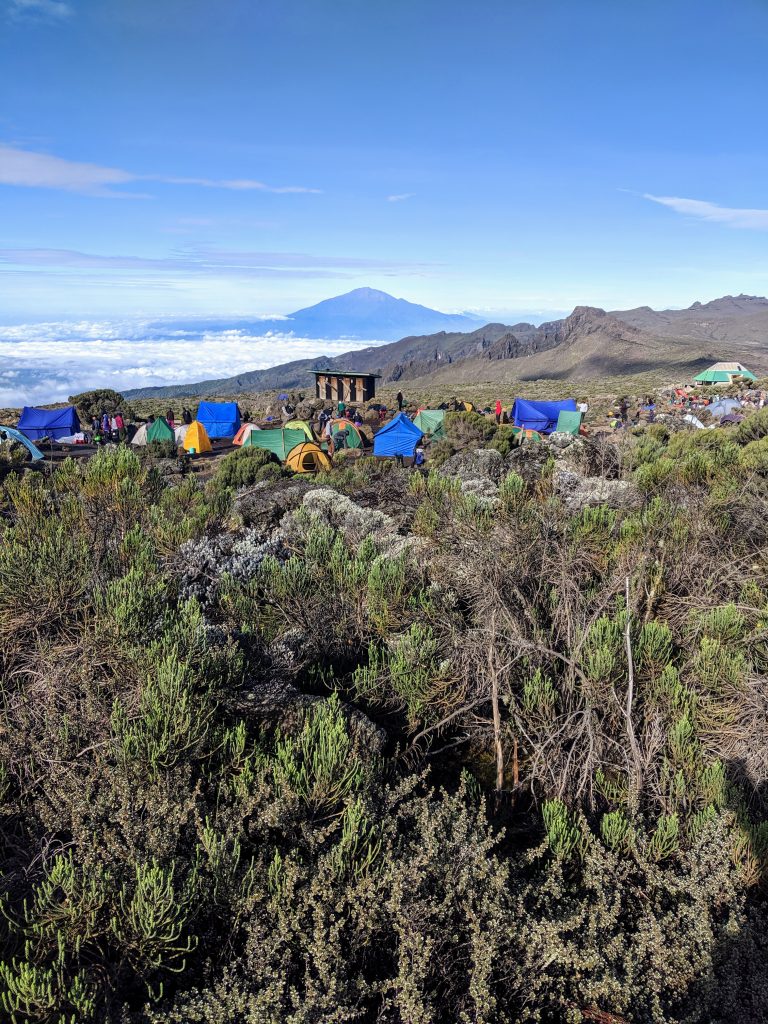
The Alpine Desert
We split into two groups on the way up to the next camp (the faster group and the slower one). It was a sluggish start but again we were racing against the rain. The aim for the day was to reach Lava Tower, which stands at 4600m where we would have lunch and then make our way down to Barranco camp at a lower elevation of 3960m. The purpose of doing this was to acclimatize and was also a chance for the guides to make a judgment on how ready (or capable) we would be to climb the summit in a few days.
The terrain became very ‘deserty’ as we ascended above the clouds on a relatively steep climb for most of the way (you’ll notice the cactus-like vegetation in the pics). Our Lomosho route intersected with another on the way up to Lava Tower and thus there was a lot of people hiking here including porters and guides for each group. The porters for our group also split as some made their way to Barranco to setup the sleeping tents for us while the others passed us on the way to Lava Tower to setup the toilet and the dining tent.
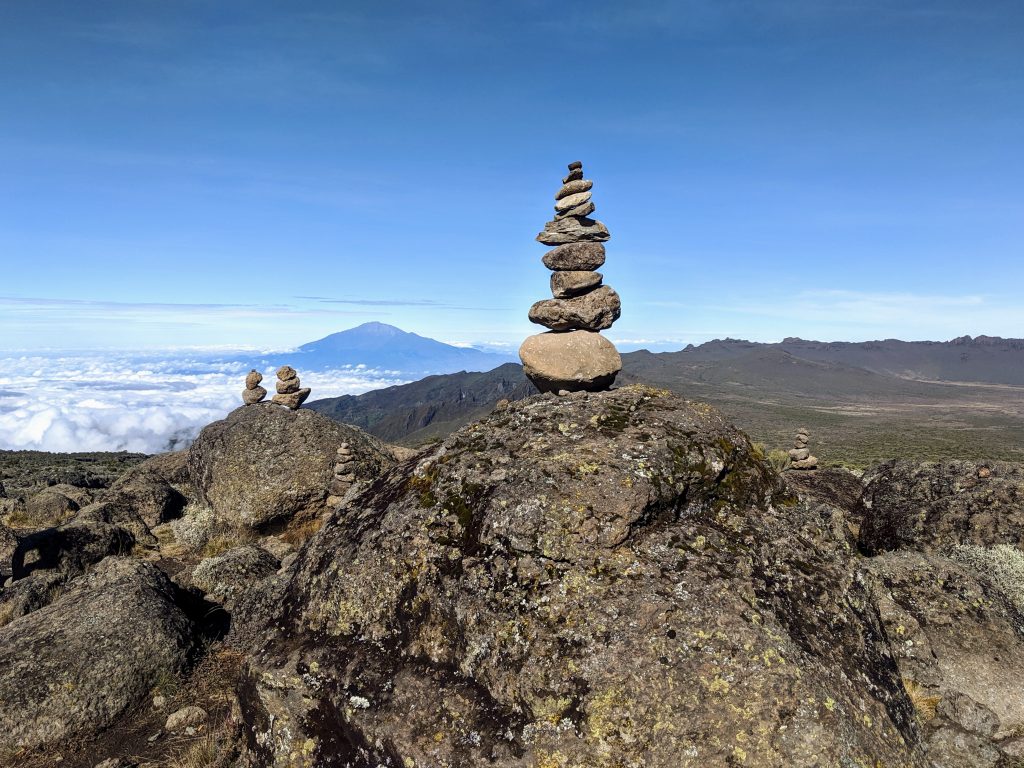
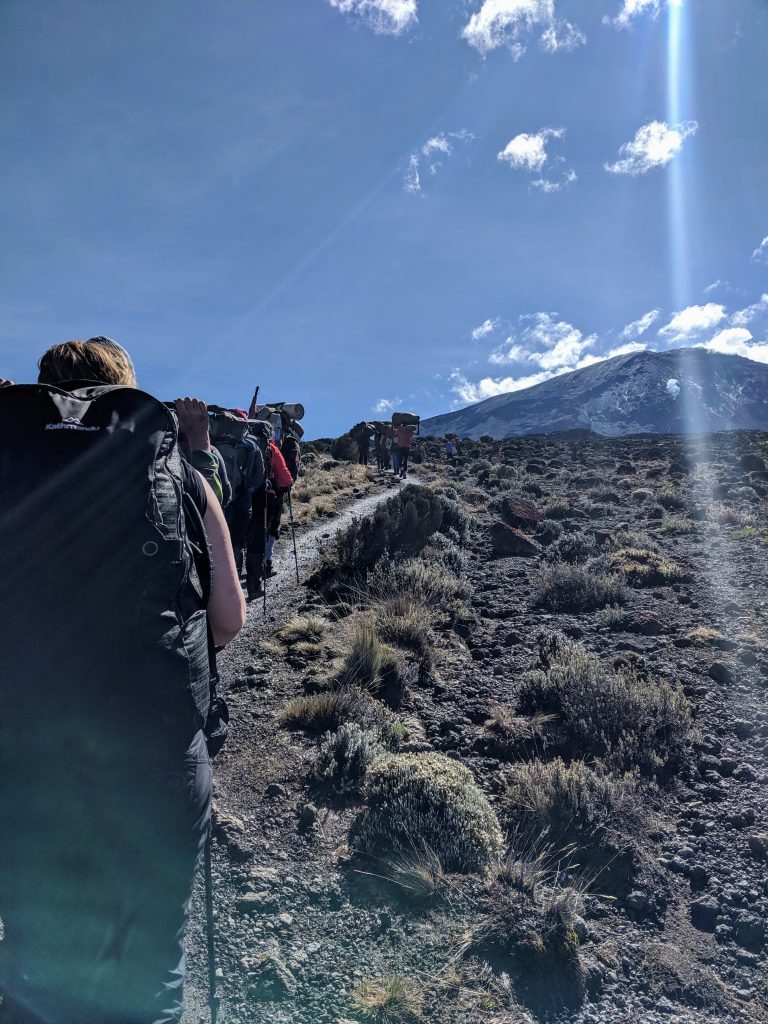
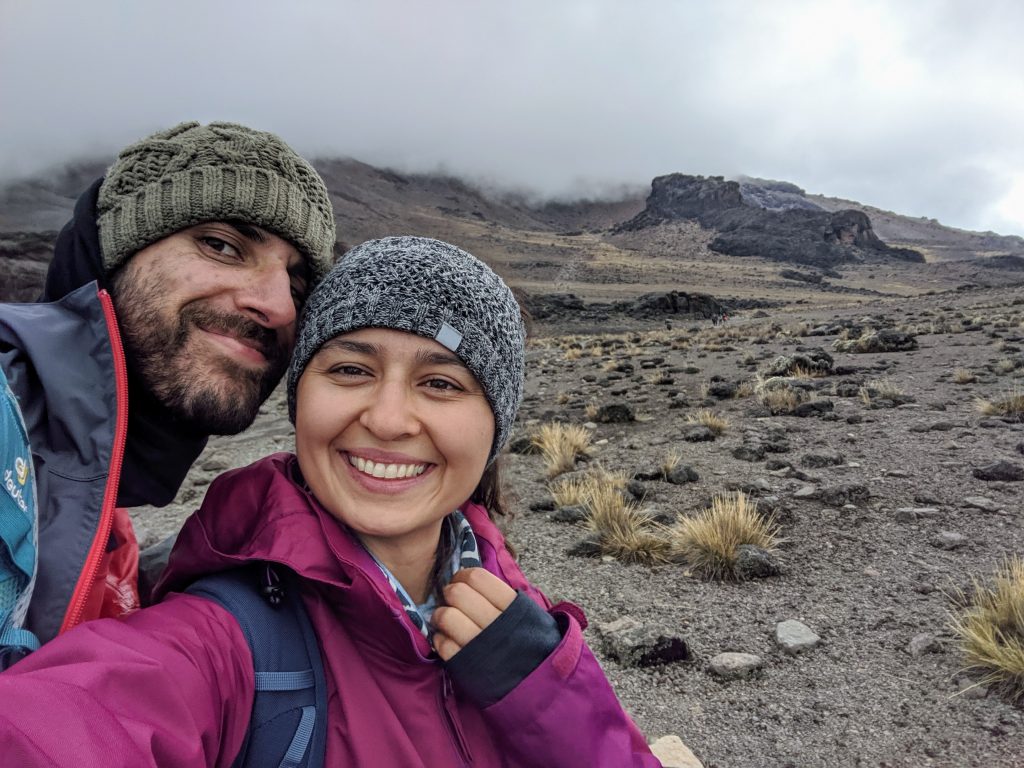
Lava Tower
We eventually got to Lava Tower just as the rain had begun and the temperature had dropped (“The cold, it comes slowly you know”) considerably. We had another good lunch, albeit Shri ate slightly less than his usual 5 plates so others had the chance to have a bit more than usual given his appetite loss. We didn’t have the cards with us in the day pack so following lunch we broke out into random conversation topics which included the climb so far, what the climb was going to be like the next day, and if the conspiracy theories surrounding the moon landing had any validity.
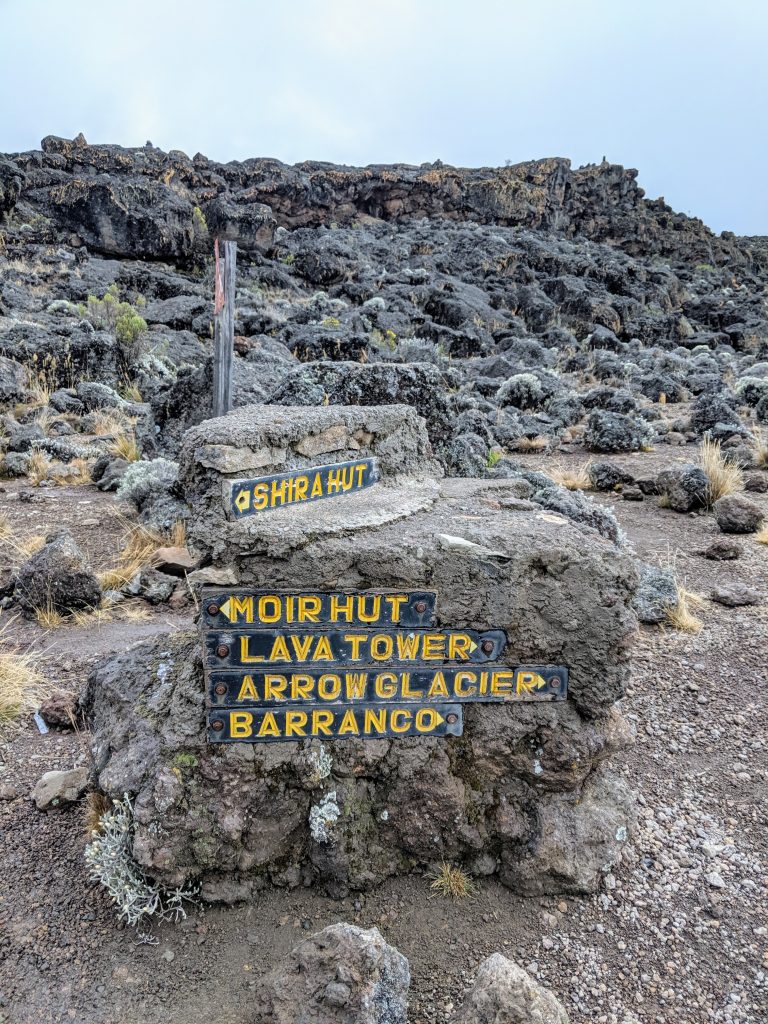

None of us wanted to go back out into the rain but the guides told us that if we wait for the off chance that the rain might stop, we’re just going to get colder and so we left with all of our ‘waterproof’ gear on. The climb down to Barranco was a steep descent, and extremely rocky and a lot of caution was needed on this route, especially in heavy rain. Our guide Thomas had so far managed quite well to evade the rain without even having waterproof wear. He had gone one step better – he had brought an umbrella!
Whether because he’s a big Rihanna fan, or because he knew it would do a better job than the waterproof jackets, we’re not quite sure. But until this day he had remained dry as a bone. But without walking poles and on this steep downward path, he ended up falling a fair few times. And got wet from falling on the wet ground. So, it seems you’ll get wet either way at some point, but at least you get a choice of how it happens!
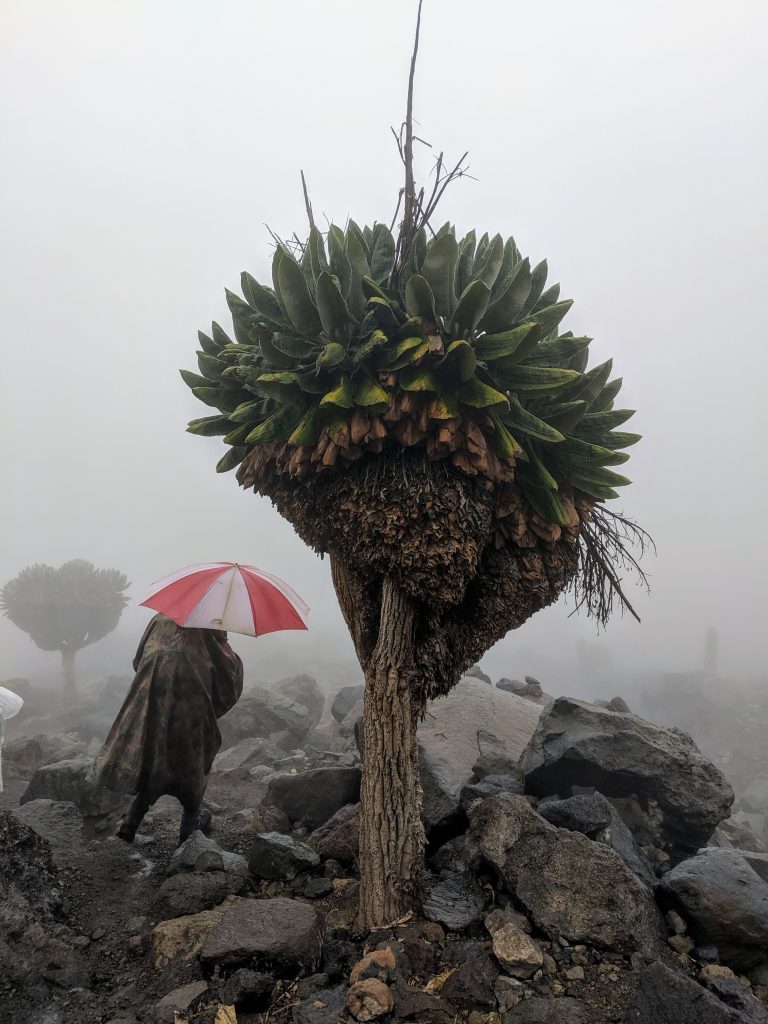
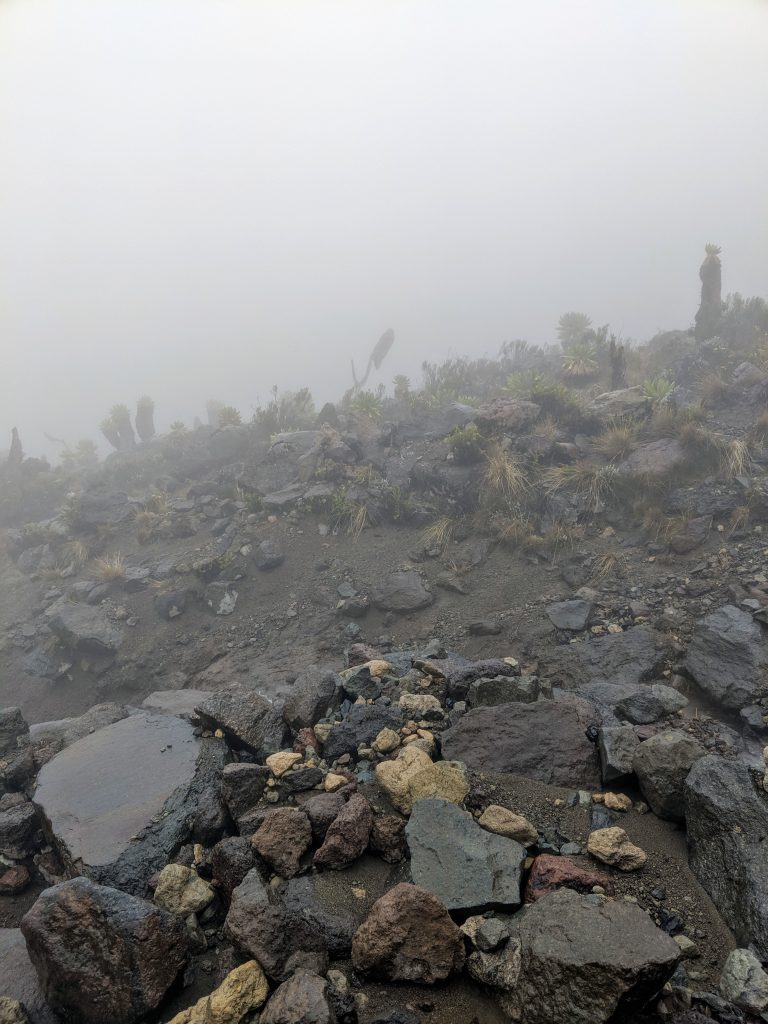
Barranco – A Night in the Mist
When we finally arrived at Barranco we could barely see anything. According to Casper and ‘The Porter’ their tent was placed not far from a cliff edge – but we couldn’t really see by the time we had arrived. Even just leaving the main dining tent to go to the toilet or back to your own was difficult with headlights due to the dense mist surrounding us. It wouldn’t be until morning that we’d see what we were up against for the next day.
Briefing and medical
As had been the case each night after dinner, the guides came and did a briefing for the next day and did a brief assessment of our wellbeing. They’d ask us how we were feeling, take our pulse rate and oxygen levels and ask us about our appetite and if we’d been having headaches etc. On this occasion Chunga said to Shri during the group meeting: “So you had diarrhoea 4 times last night. How about today”? Of course he hadn’t had anymore on this day due to Imodium, but here outlines the fact that there is no privacy on the mountain – everyone is going to know your business so if you do get the runs, it’s best to share it with the group as it’s going to come out at some point or another (no pun intended)!
Day 5: Keranga Camp (3995 metres)
Above the Clouds
When we awoke the next day, the mist had cleared and we had a clear view of where we were and where we were going. Down below, we could see literally a sea of clouds all suspended far below our camp – were we going to be rain-free for the rest of the climb? Looking in the opposite direction to these clouds was the route we would be taking that day. It looked like a mammoth task, as it was basically a massive, steep wall that we’d be climbing up and supposedly going over to get to the other side and Keranga camp. If ever there was a sight to make us give up, as we packed our stuff in the shadows of this massive rock, it was now.
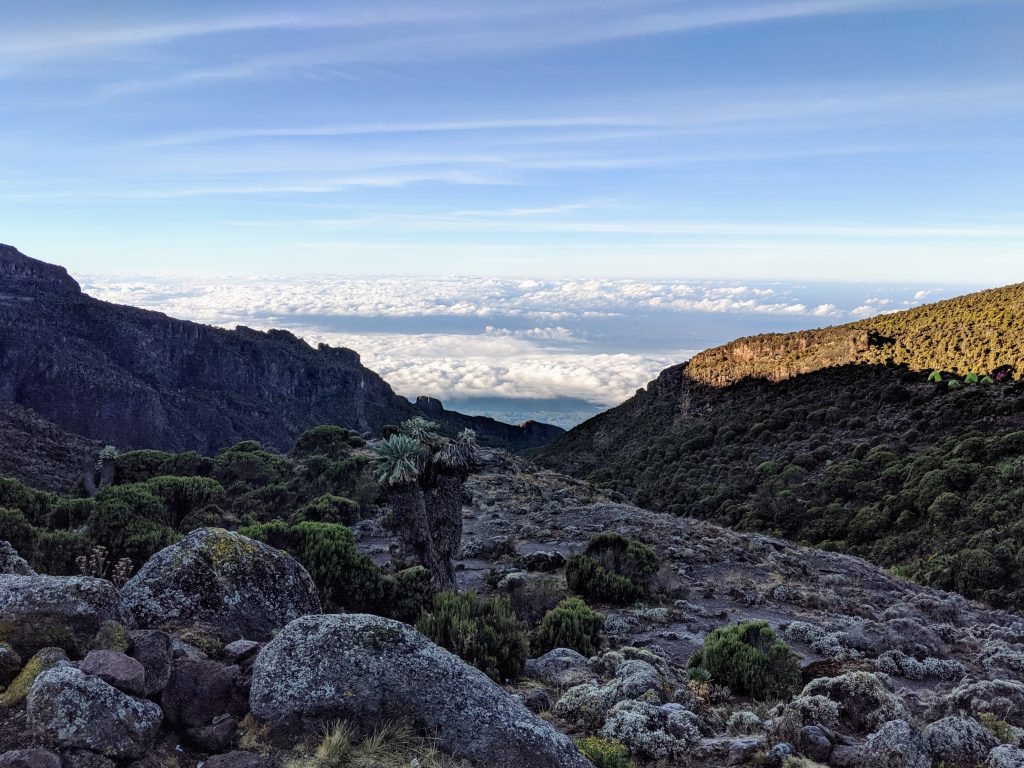
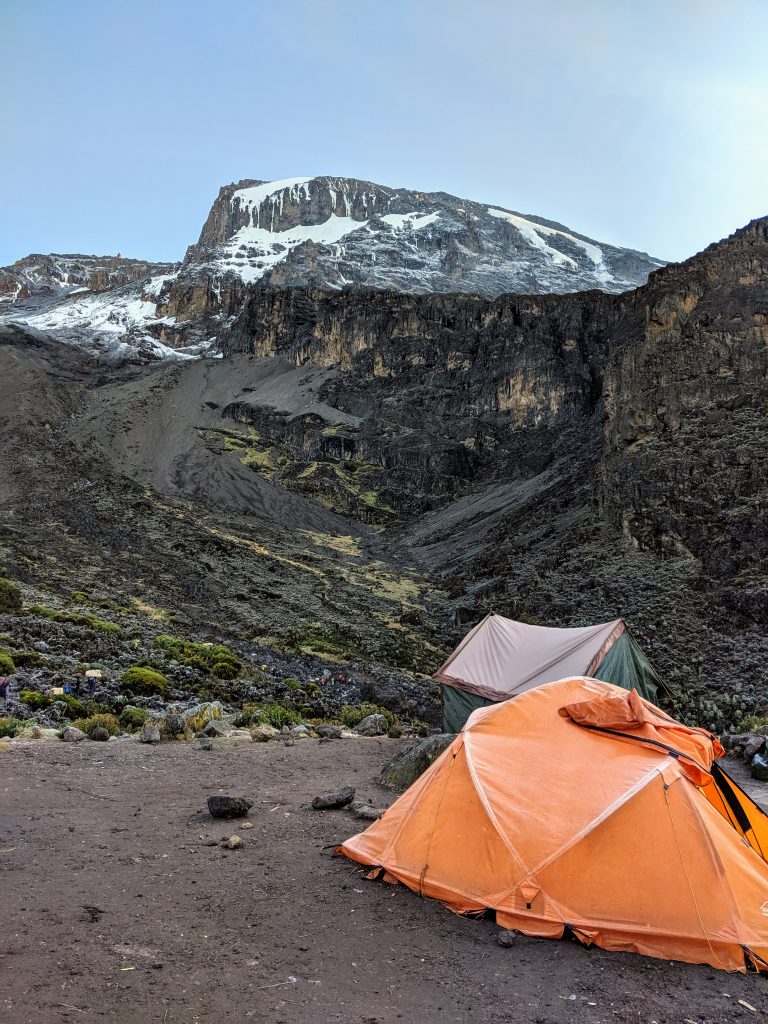
We spoke with one of the porters Justin, who was on his first ever climb as a porter and this being his first time on Kilimanjaro in general. We don’t often take the time to envision what it must be like for someone who is working there on what must be a crazy experience going up the largest free standing mountain in the world with an excess of baggage on your back (or head or neck), having never done it before! He said he was quite nervous and wasn’t sure if he would make it as the prospect looked quite daunting.
After breakfast the time came to finally accept the challenge of the day and see if we really were worthy of reaching the summit. Join us in part II, and see how far we make it up Kilimanjaro!
E Kohut
28 Dec 2019That’s amazing guys ! Truly inspiring to do more … My daughter and I enjoyed reading your blog ..Good luck with your next journey xxx
shirishj
27 Jan 2020Glad you enjoyed it Eli!
Hans D Wolfstaedter
31 Jan 2020Love the tale, like always!
maseczki na twarz
24 Dec 2020Good blog you’ve got here.. Itís difficult to find excellent writing like yours these days. I really appreciate people like you! Take care!!
maseczki z filtrem
27 Dec 2020I’m extremely pleased to discover this website. I wanted to thank you for ones time just for this fantastic read!! I absolutely enjoyed every part of it and i also have you bookmarked to see new stuff in your site.
cialis buy
28 Dec 2020Definitely, what a great blog and revealing posts, I definitely will bookmark your site. Best Regards!
pożyczki online
2 Jan 2021I got what you intend,bookmarked, very decent website.
emergency car locksmith
3 Jan 2021I am incessantly thought about this, thanks for posting.
renault clio key fob
3 Jan 2021Some really great info, Gladiola I detected this. I’m not spaming. I’m just saying your website is AWSOME! Thank you so much! Please vist also my website.
chwilówki
3 Jan 2021I reckon something truly special in this website.
Gus
8 May 2023Your writing is compelling, it’s difficult to look away.